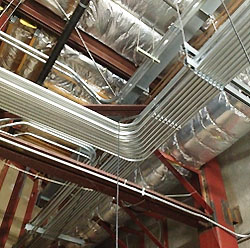I get to talk to a lot of churches now. Being involved with a number of church renovation projects each year, I hear some interesting strategies.
One of those strategies is to not run conduit for AVL wiring, but to plan on doing what we call “free air” wiring instead.
Free air is just what it sounds like; the cable is running through free air. There may be ceiling trusses or beams to attach to, but for the most part, the cable is just running up there in the air, outside of conduit.
Now, I get the premise behind this; conduit is expensive! Those pesky electrical contractors (ECs) charge a pretty penny to install and terminate conduit.
And when you talk to AVL integrators, they’re going to want a lot of conduit! So it seems like a great way to save money is to skip the whole conduit thing and just have the AV company free air all the wire. Or at least a lot of it. That should save a ton of cash, which lowers the overall cost of the project.
Win-win!
Not So Fast
That’s the big problem with running wire free air; it’s not so fast. Let’s take the example of pulling up wire to a stack of loudspeakers.
There will likely be several runs of individual cable going up to each loudspeaker cluster. If there’s a conduit that starts at the rack room, and ends at the loudspeakers, it’s a simple matter of laying out the cable and pulling it through the conduit. It doesn’t take long at all.
However, if that loudspeaker wire has to be threaded through the ceiling trusses, across and over, down and around, all from a lift, it’s going to take a while. A good long while.
Now you might think that installing conduit will also take a while, since it has to traverse the path as well. That’s true.
However, conduit comes in 10-foot rigid pieces, and it only has to be attached in a few points. It’s a lot faster and easier to make that look good than it is to pull cable through the same space.
Moreover, if the conduit runs are laid out wisely, the EC can start pulling multiple conduit through the same path, which makes if even faster for the cable pull.





















